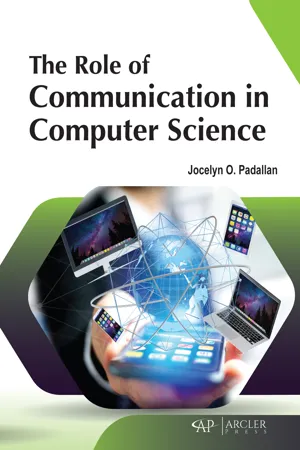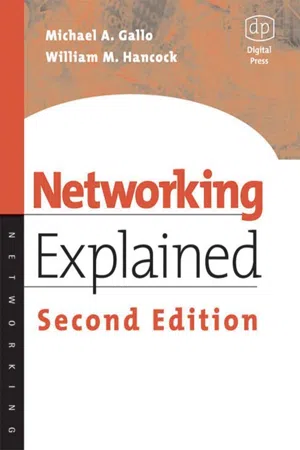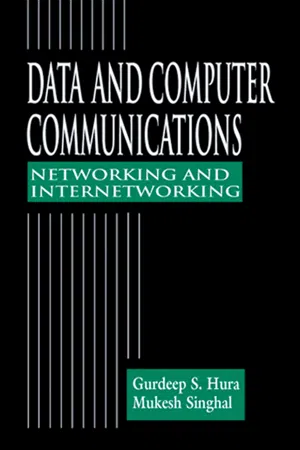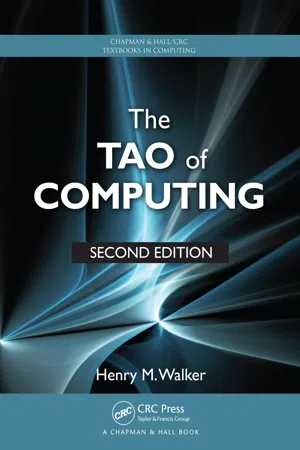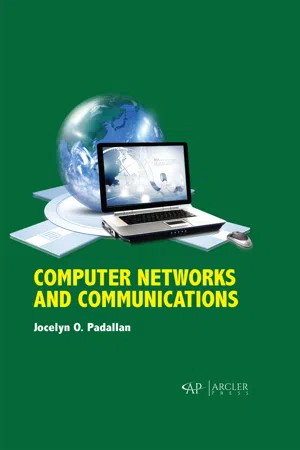Computer Science
Computer Network
A computer network is a collection of interconnected devices, such as computers, servers, and other hardware, that communicate with each other to share resources and information. Networks can be wired or wireless and can range from small local area networks (LANs) within a single building to global wide area networks (WANs) connecting multiple locations.
Written by Perlego with AI-assistance
Related key terms
1 of 5
11 Key excerpts on "Computer Network"
- No longer available |Learn more
Data Communications and Computer Networks
A Business User's Approach
- Curt White, , , (Authors)
- 2021(Publication Date)
- Cengage Learning EMEA(Publisher)
That handheld device you are holding can play music, make phone calls, take pictures, surf the Web, and let you play games while you wait for the next train. Welcome to the amazing world of Computer Networks! Unless you have spent the last 24 hours in complete isolation, it is nearly impossible to not have used some form of Computer Networks and data communications. Because of this growing integration of Computer Networks and data communications into business and life, we cannot leave this area of study to technicians. All of us — particularly information systems, business, and computer science students — need to understand the basic concepts. Armed with this knowledge, we not only will be better at communicating with network specialists and engineers, but also will become better students, managers, and employees. THE LANGUAGE OF Computer NetworkS Over the years, numerous terms and definitions relating to Computer Networks and data communications have emerged. To gain insight into the many subfields of study, and to become familiar with the emphasis of this textbook, let us examine the more common terms and their definitions. A Computer Network is an interconnected group of computers and comput-ing equipment using either wires or radio waves that can share data and comput-ing resources. Computer Networks that use radio waves are termed wireless and can involve broadcast radio, microwaves, or satellite transmissions. Networks spanning an area of several meters around an individual are called personal area networks (PANs) . Personal area networks include devices such as laptop computers, smart cell phones, music players, and wireless connections. Networks that are a little larger in geographic size — spanning a room, a floor within a building, or an entire building — are local area networks (LANs) . Collections of local area networks that cover a campus (such as a college campus or a business campus) are often called campus area networks (CANs) . - Jocelyn O. Padallan(Author)
- 2023(Publication Date)
- Arcler Press(Publisher)
The following three elements of a computer system will be the primary focus of this chapter. However, first of all, and foremost, what exactly is meant by the term “Computer Network”? The reader must be made aware that from this point forward, the phrase “Computer Network” will be used to refer to a conventional computer system. A computer system is a dispersed system that is composed of computers that are only tenuously linked to one another (Wang et al., 2006). Through the use of a medium of communication, any two of these devices can communicate with one another. From this point forward, we shall refer to these communication mediums as network equipment or transmission elements. For this collection of interconnected devices to be referred to as a communication network, there must be a predetermined set of guidelines, sometimes known as a protocol, so each device should adhere to them to have a successful conversation with some other device that is part of the network. The integration of software and hardware results in the creation of a computerized communication network, more often mentioned simply as a computer system. A diagram of a Computer Network is shown in Figure 3.1 (Jingna, 2010). Networking devices are a collection of nodes that make up the hardware component. These nodes involve end systems like hosts as well as intermediate step switching elements like port facilities, routers, bridges, and gateways. For the sake of clarity, we will refer to these nodes collectively as system components. The hardware part is made up of networking devices (Akyildiz et al., 2012). Each component of the network has capabilities either locally or internationally. The term “network software” refers to all software applications and communications networks that are utilized to coordinate, synchronize, and carry out the tasks of data sharing and exchange among the Fundamentals of Computer Networks 73 various components of a network.- eBook - PDF
- Michael Gallo, William M. Hancock PhD CISSP CISM, William M. Hancock, PhD, CISSP, CISM(Authors)
- 2001(Publication Date)
- Digital Press(Publisher)
3. OK. Now that I have some idea of what networking is, what exactly is a Computer Network? A Computer Network is a collection of computers and other devices that use a common network protocol to share resources with each other over a network medium. 4 Networking Explained, Second Edition 4. That’s a mouthful. Can you break this down for me, please? There are several terms I do not understand. Sure. Where do you want to start? 5. First of all, you say a Computer Network is a collection of computers and other devices. What other devices? In our definition we use the term device to represent any entity that is connected to a network. Such entities may be terminals, printers, computers, or special network-related hardware units such as communication servers, repeaters, bridges, switches, routers, hand-held units such as the PalmPilot , and various other devices, most of which are discussed in detail in later chapters. Devices can be either local or remote. The device originating com-munication across a network is called the local device or sending device , and any device within the network that is accessed from this local device is called the remote device or receiving device . In a telephone network, the telephone handsets we all use are devices. So is the interconnecting hardware at the phone company that allows handsets to talk to each other. A network requires many diverse types of devices in order to work. 6. So device is a generic term. Correct. 7. What about node ? I see this term used frequently. The word node is commonly used interchangeably with device; both terms refer to any equipment that can access a network. You also frequently see the term station as well as appliance used in the literature. Both are synonymous with device and node. All four terms refer to any equipment that can access a network. - eBook - PDF
- Jocelyn O. Padallan(Author)
- 2020(Publication Date)
- Arcler Press(Publisher)
3.1. INTRODUCTION Computer Networks are an integral part of modern life. A Computer Network is used for the simplest of things like the withdrawal of cash from an automated teller machine (ATM). Sending mails and browsing the internet also takes place through a Computer Network which is known as the internet. There is a compelling presence of Computer Networks on human lives. Telemarketers also make use of networking to sell their products. People watch various channels on their television through Computer Networks. These transport programs onto the TV screens. The mobile phone which is an integral part of modern life is connected by networks, without which it will just be a battery powering-up a meaningless screen. Computer Networks provide these extraordinary services. They are responsible for the transfer of data to and from the televisions, cell phones, computers, and other modern machines. There are applications, which are a part of the network and translate these data. These get projected as TV images, icons on PC screens, and text messages. The networks fetch data from all parts of the world. The tasks are performed by these networks in a second or even less irrespective of the distance. 3.2. Computer Network A Computer Network comprises of two or more connected computers. There are two aspects of these connections: • The physical connection is through wires, cables, and wireless media such as cell phone; and Overview of Computer Networking 55 • The logical connection is through the physical media through which data is transported. The networking computers comprises of more than just physical connectors like ports on the PC and electrical plugs. The Computer Networking or exchange of data happens through several basic rules. Figure 3.1: Representation of Computer Network. Source: Image by Pixabay. - eBook - PDF
Data and Computer Communications
Networking and Internetworking
- Gurdeep S. Hura, Mukesh Singhal(Authors)
- 2001(Publication Date)
- CRC Press(Publisher)
A Computer Network connects several geographically dispersed computers so that they can exchange information by message passing and one computer can access resources available to other computers. If computers are connected by a network , then existing information on them can be shared. A Computer Network provides the facility of information exchange among the com-puters connected to it. A network provides the ability of resource sharing to its users such that users of any computers (working under any environment) connected via a network can access the data, programs, resources (hard disks; high-quality, expensive laser printer; modems; etc.), peripheral devices, electronic mail (e-mail), software, etc., regardless of their physical locations. The physical distance between computers can be from a few feet to thousands of miles, but the users and computers exchange data and programs in the same way as they do locally. Regardless of the distance, a network creates a global environment for the users and the computers. Resource sharing is one of the main advan-tages of networks. Resources such as printers, files, peripheral devices, disks, computers, and even people can be connected together. This interconnectivity allows faster, better, more reliable mobile communications, such as cellular and wireless. Very large files, 4 Data and Computer Communications: Networking and Internetworking programs, software, graphic files, computer-aided design tools, and many other tools can be transferred over the networks. Sending and receiving e-mail via online services such as America Online (AOL), CompuServe, and many others over networks around the world adds a high degree of mobility. One of the main disadvantages of networks is the cost of network equipment and various software operating systems and applications modules. - eBook - PDF
- Vojin G. Oklobdzija(Author)
- 2019(Publication Date)
- CRC Press(Publisher)
others in an asynchronous fashion, there was also need for computers to exchange information among themselves. The information being exchanged in this fashion has different characteristics than the information being exchanged through the telephone systems. This need led to the interconnection of computers w ith each other and that is what is called Computer Networks. 26.4.3 Computer Networks Computer Networks is an interconnection of computers. The interconnection forms a facilit y that prov ides reliable and efficient means of communication among users and other dev ices. User commu-nication in Computer Networks is assisted by computers, and the facilit y also prov ides communication among computers. Computer Networks are also referred to as computer communication networks. Interconnection among computers may be v ia w ired or w ireless transmission medium [5,6,10,13,18]. There are two broad categories of Computer Networks: . Wide area networks . Local = metropolitan area networks Wide area Computer Networks, as the name suggests, span a wid er geographical area and essentially have a g lobal scope. On the other hand, local = metropolitan area networks span a limited distance. Local area networks are generally confined to an industrial building or an academic institution. Metropolitan area networks also have limited geographical scope but it is relatively larger than that of the local area networks [19]. Typical wide and local = metropolitan area networks are shown in Fig . 26.23 . Once a user is connected to a Computer Network, it can communicate with any other user that is also connected to the network at some point. It is not required that a user must be connected directly to another user for communicating. In fact, in wide area networks, two communicating users will rarely be directly connected with each other. This implies that the users will be sharing the transmission links for exchanging their information. - eBook - PDF
- Henry M. Walker(Author)
- 2012(Publication Date)
- Chapman and Hall/CRC(Publisher)
Similarly, you may share pictures or interact with others through a social networking site. In these applications, you are communicating with people around the 276 ◾ The Tao of Computing world easily and quickly, without apparent regard for where they are or how data might travel between you and them. Although these applications may seem different, they all depend on basic concepts of file sharing and networking. In the past, when machines worked in isolation rather than in Computer Networks, each individual machine kept track of its own files, and options for sharing information were quite limited. When a user typed a document on her or his machine, the machine stored an appropriate file on its own local hard drive. Today, most of our computers are connected in networks, and files can be distributed widely. You could, for example, easily write a group paper with a fellow student who is studying abroad in Australia, and it would be almost as simple as if she were in the room next door. Networks allow indi-viduals to access files stored on many machines, and in some cases several people can access the same files concurrently. In obtaining weather information, you may be relying on a cen-tral information source (e.g., the weather bureau), and you want your computer to present you with regular updates over the network. When you participate in chats and collabora-tions with others over the network, information must flow to the desired parties smoothly. All of this communication of files is certainly convenient, but the underlying technol-ogy is highly complex. In Chapter 9, we explored the hardware involved with Internet com-munication. In this chapter, we address both the underlying systems programs and some applications that work with the hardware. - eBook - PDF
- R. Kelly Rainer, Brad Prince(Authors)
- 2021(Publication Date)
- Wiley(Publisher)
In March 2019 Spectrum began paying out $62.5 million to customers over the Internet speed lawsuit. You begin this chapter by learning what a Computer Network is and by identifying the vari- ous types of networks. You then study network fundamentals. You next turn your attention to the basics of the Internet and the World Wide Web. You conclude by examining the many network applications available to individuals and organizations—that is, what networks help you do. 6.1 What Is a Computer Network? A Computer Network is a system that connects computers and other devices (e.g., printers) through communications media so that data and information can be transmitted among them. Voice and data communication networks are continually becoming faster—that is, their band- width is increasing—and cheaper. Bandwidth refers to the transmission capacity of a network; it is stated in bits per second. Bandwidth ranges from narrowband (relatively low transmission capacity) to broadband (relatively high network capacity). Author Lecture Videos are available exclusively in WileyPLUS. Apply the Concept activities are available in the Appendix and in WileyPLUS. 170 CHAPTER 6 Telecommunications and Networking The telecommunications industry itself has difficulty defining the term broadband. The Federal Communications Commission’s (FCC) rules define broadband as the transmission capacity of a communications medium (discussed later in this chapter) faster than 25 megabits per second (Mbps) for download—the transmission speed for material coming to you from an Internet server, such as a movie streamed from Netflix—and 3 Mbps for upload—the trans- mission speed for material that you upload to an Internet server such as a Facebook post or YouTube video. Interestingly, some Federal Communications Commission (FCC; www.fcc.gov) members feel that the definition of broadband should be increased to 100 Mbps for download. - eBook - PDF
- Greg Tomsho(Author)
- 2019(Publication Date)
- Cengage Learning EMEA(Publisher)
Windows Server, Mac OS X Server, UNIX, and many Linux distributions fit this description. • Server computer—This term is used when a computer’s primary role in the network is to give client computers access to network resources and services. The computers that most often fit this description are usually in the IT room or locked away in a closet. • Server software—This is the software that responds to requests for network resources from client software running on another computer. A Web server (such as Internet Information Services), an e-mail server (such as Microsoft Exchange), and File and Printer Sharing for Microsoft Networks fit into this category. As you can see, the lines between a client computer and a server computer are often blurred because OSs are designed as network operating systems, and most computers can take on the roles of both server and client. As you’re learning, however, the language of networking is often imprecise, and you must pay attention to the Note Microsoft refers to server software components as “services.” Other OSs use other terms; for example, in Linux/UNIX, server software components are referred to as “daemons.” Copyright 2020 Cengage Learning. All Rights Reserved. May not be copied, scanned, or duplicated, in whole or in part. Due to electronic rights, some third party content may be suppressed from the eBook and/or eChapter(s). Editorial review has deemed that any suppressed content does not materially affect the overall learning experience. Cengage Learning reserves the right to remove additional content at any time if subsequent rights restrictions require it. CHAPTER 1 Introduction to Computer Networks 37 context in which networking terms are used to grasp their meaning. As you get more comfortable with all the terms and better understand how networks work, the nuances of the terminology will fall into place. - eBook - PDF
- Jocelyn O. Padallan(Author)
- 2019(Publication Date)
- Arcler Press(Publisher)
INTRODUCTION TO Computer NetworkS AND COMMUNICATION 1 CHAPTER “Technology has forever changed the world we live in. We’re online, in one way or another, all day long. Our phones and computers have become reflections of our personalities, our interests, and our identities. They hold much that is important to us.” — James Comey CONTENTS 1.1. Introduction ........................................................................................ 2 1.2. Networks ............................................................................................ 5 1.3. Reference Models ............................................................................... 6 1.4. Physical Attributes of a Network ......................................................... 8 1.5. Analog and Digital Communication .................................................. 11 1.6. Transmission Impairment .................................................................. 12 1.7. Wireless Communication .................................................................. 15 1.8. Cellular Network .............................................................................. 19 1.9. Protocols and Standards .................................................................... 20 References ............................................................................................... 23 Computer Networks and Communications 2 The following chapter describes the basics of Computer Networks and communication that includes the major components of a communication system, different types of networks, and various modes of data transmission. Further, a general overview of reference models, i.e., ISO OSI Model and TCP/IP model in data communication has been given in the chapter. A general differentiation between analog and digital communication has been provided along with impairments in the transmission that includes attenuation, distortion, and noise. - eBook - PDF
- Greg Tomsho(Author)
- 2015(Publication Date)
- Cengage Learning EMEA(Publisher)
To understand how networks work, however, you need to learn about the underlying technol-ogies and processes used when you open a Web browser or an e-mail program. A good place to start is with the components that make a stand-alone computer a networked computer. Network Components Imagine a computer with no networking components — no networking hardware or software. It ’ s hard to imagine in this age of seemingly everything being connected. However, not too long ago, when you bought a computer, its main purpose was to run applications such as word-processing and spreadsheet programs, not Web browsers and e-mail. In fact, a com-puter had neither the hardware nor software needed to run these programs. These computers were called stand-alone computers . If you wanted to network this type of computer, you had to add these required components: • Network interface card — A NIC is an add-on card that ’ s plugged into a motherboard expansion slot and provides a connection between the computer and the network. Most computers have a NIC built into the motherboard, so no additional card is necessary. NICs are discussed in more detail in Chapter 2. • Network medium — A cable that plugs into the NIC and makes the connection between a computer and the rest of the network. In networks with just two computers, the other end of the cable can plug into the second computer ’ s NIC. More likely, the other end of the cable plugs into an interconnecting device that accommodates several computer connections. Network media can also be the air waves, as in wireless networks. In this case, the connection is between the antenna on the NIC and the antenna on another NIC or interconnecting device. Network media are discussed in more detail in Chapter 4.
Index pages curate the most relevant extracts from our library of academic textbooks. They’ve been created using an in-house natural language model (NLM), each adding context and meaning to key research topics.

